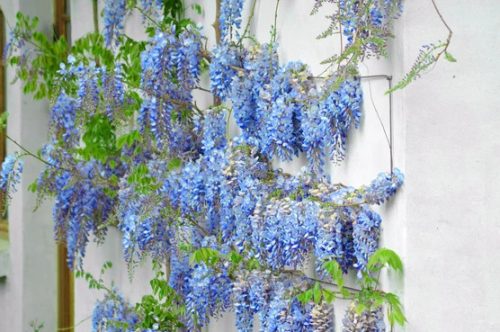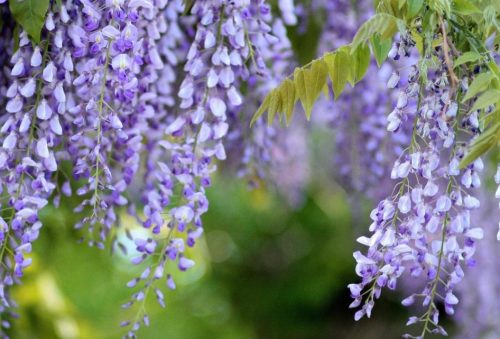The Blue Chinese Wisteria Tree is a favorite among gardening enthusiasts for its enchanting beauty and subtly fragrant flowers. In this article, we will explore the unique characteristics and essential care practices for this plant, as well as thoughtful planting tips that will make the Blue Chinese Wisteria Tree a splendid addition to any outdoor landscape.
A quick overview of the Blue Chinese Wisteria Tree

The Blue Chinese Wisteria Tree, scientifically known as Wisteria sinensis, is a deciduous tree native to China. Its petite stature classifies it as a small tree, typically maturing at a height of 10 to 15 feet. Despite its modest size, this plant is characterized by its rapid growth rate, making it a favorite choice among gardening enthusiasts.
During the summer months, Blue Chinese Wisteria has dark green leaves that turn brilliant yellow in the fall, creating a dramatic display. The structure of this tree is compact, with a rounded canopy growing on a main stem. One of its most enchanting features is its elegantly drooping 1-foot-long clusters of wisteria flowers, which provide a spectacular sight where the plant is planted.
In addition, the flowers of the Blue Chinese Wisteria Tree have a fragrance that attracts pollinators such as bees and butterflies.
However, Blue Chinese Wisteria’s meteoric rise comes with a warning. Due to its vigorous nature and ability to self-seed, this plant is often considered an invasive species in various regions of the United States. Managing its growth requires constant maintenance to prevent unwanted seed dispersal, which has the potential to disrupt local ecosystems.
Therefore, before deciding to plant a Chinese Wisteria Tree, it is imperative to check with local authorities to ensure compliance with regulations and restrictions on planting potentially invasive species.
Planting and maintenance guidelines for the Blue Chinese Wisteria Tree

Soil
Loam, silt, or sandy soils will all work for Blue Chinese Wisteria as long as they have adequate drainage. Enough air spaces in the soil mixture should allow the root system to get oxygen. As long as the soil is not too wet, planting wisteria in moist soil is acceptable.
Use organic ingredients like compost, aged manure, or peat moss to modify the soil in order to improve its fertility and structure. These changes will aid in releasing compaction. A pH of 4.5 to 7 is ideal for soil.
Lighting
One thing needs to be kept in mind when it comes to lighting. More sunlight is preferable. The full sun is ideal for wisteria trees since it encourages abundant blooming. But it will also thrive in partial shade if it still receives four or five hours of sunlight each day.
But plant wisteria trees in an open space with lots of light if you want to see the profusion of fragrant flowers.
Watering
Once rooted, wisteria trees are known to withstand droughts well. Thus, you won’t have to water a mature wisteria tree as frequently. To support the growth of young plants, you will need to water frequently during the early stages.
Make sure to immerse the root ball each time you water, and keep the soil moist. By doing this, you will be assisting the Wisteria Tree in growing a large root system.
It is not a good idea to water frequently enough to the point where the soil gets soaked. The wisteria tree may eventually die as a result of this developing root rot. Don’t forget to provide what your container plant requires.
Temperature and Humidity
Wisteria trees grow well outdoors if they are planted in one of the USDA zones 5 through 9. It is capable of withstanding temperatures as high as 30°F (-1.2°C) and as low as -20°F (-26°C). However, if your home is in a much colder climate, a potted wisteria tree will thrive.
In order to keep it safe from harm over the winter, you will need to move it inside.
Fertilizer
It is best to plant a wisteria tree in rich soil. Apply slow-release fertilizer meant for woody plants, such trees and shrubs, in the early spring. This facilitates flowering and promotes lush growth.
Pruning
The wisteria plant requires regular pruning due to its rapid growth. During the growing season, light pruning can be done to keep the vine neat by getting rid of outgrowths. However, wait until the plant has finished blooming if you wish to heavily prune it to make the entire plant smaller.
Propagating
Consider reproducing your Chinese wisteria tree if you want an abundance of wisteria flowers. This is a simple technique that uses softwood cuttings. The best cuttings to propagate are the ones you took during your most recent trimming, with the stronger ones being chosen.
This is a detailed how-to for effective propagation:
– Pick Softwood Cuttings: Softwood cuttings should be between three and six inches long, with a green hue and no fully grown bark. Make sure there are two leaves on each cutting.
– Apply Rooting Hormone: For a brief period of time, dip the softwood cutting’s rooting end into a rooting hormone. This promotes the growth of roots.
– Plant in Potting Media: Plant the cutting in a hole dug in potting media, pressing dirt to stabilize it around it.
– Water completely: To encourage early growth, water the potting material completely. Keep an eye on the moisture content of the soil and add water as necessary to maintain a constant moisture level.
– Cover with Plastic Bag: Place a plastic bag over the top portion of the clippings to retain moisture and keep them from drying out.
– Provide Indirect Light: To create the ideal environment for root development, place the pot in a bright, indirect light location.
– Root Development: The cuttings should start to take on roots in four to six weeks. Consider moving them into a bigger container once they have grown to a suitable size.
By following these simple steps, you can propagate your Chinese wisteria effectively, allowing you to enjoy an increased abundance of its beautiful flowers. This process not only enhances your garden’s aesthetics but also provides an opportunity to share the beauty of the wisteria with others.
Potting
It is possible to grow Wisteria in a container due to its small size. On the other hand, more work will be needed for upkeep and care. After obtaining your tree, transplant it into a pot that is two inches bigger than the one in which it was originally placed.
Wisteria plants grow a large network of roots. Therefore, before repotting, you can trim off any old and unhealthy portions of the roots. Make use of standard potting soil that drains properly and is sterile. After repotting, give your wisteria tree frequent waterings to encourage the roots to take up residence in their new surroundings.
Repotting young wisteria trees should be done every two years. However, you should apply it every three to five years for established plants.
People Who Read This Also Read:






